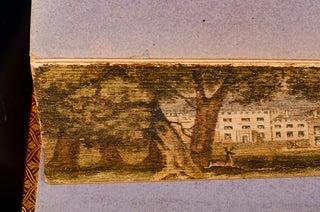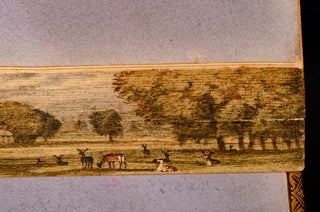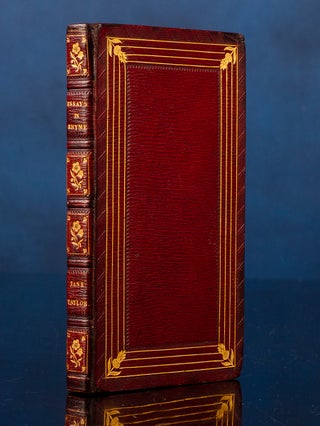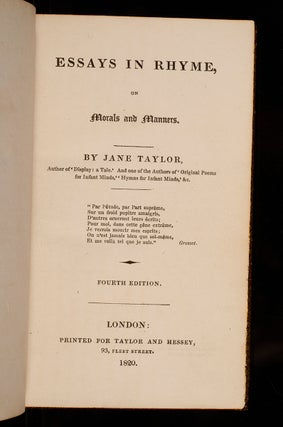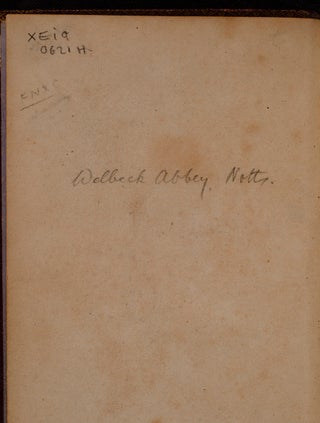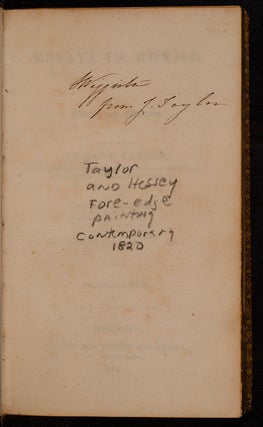Essays in Rhyme on Morals and Manners
London: Printed for Taylor and Hessey, 1820. Item #05174
A Superb Contemporary Fore-Edge Painting by Taylor & Hessey
Inscribed by Jane Taylor, the Author of "Twinkle, Twinkle Little Star" to her Sister, Ann Taylor
[FORE-EDGE PAINTING]. [TAYLOR & HESSEY, binder]. TAYLOR, Jane. Essays in Rhyme on Morals and Manners. By Jane Taylor. Fourth Edition.. London: Printed for Taylor and Hessey, 1820.
With a fine contemporary fore-edge painting by Taylor & Hessey depicting a view of Welbeck Abbey in Nottinghamshire.
Inscribed by the author to her sister Ann on the front blank "For my Sister/from J. Taylor".
Twelvemo (6 3/8 x 3 7/8 inches; 162 x 98 mm.). [2, blank], [iv], [1]-174, [2 blank] pp.
Bound ca. 1820 by [Taylor and Hessey, Booksellers, London] in full maroon straight-grain morocco. Covers decoratively paneled in gilt and blind, spine with five raised bands, decoratively tooled in gilt and blind and lettered in gilt in compartments, decorative gilt board edges and turn-ins, lilac endpapers, all edges gilt.
A superb example with a wonderful association.
Jane Taylor (1783-1824) was an English poet and novelist. She wrote the words to the song "Twinkle, Twinkle, Little Star", which is widely known, but it is generally forgotten who wrote it. The sisters, Jane and Ann Taylor and their authorship of various works have often been confused, in part because their early ones were published together. Ann Taylor's son, Josiah Gilbert, wrote in her biography, "Two little poems – 'My Mother,' and 'Twinkle, twinkle, little Star' - are perhaps more frequently quoted than any; the first, a lyric of life, was by Ann, the second, of nature, by Jane; and they illustrate this difference between the sisters."
“Taylor & Hessey were busy throughout these fifteen years [1808-1823], not only in publishing and in binding, but also in re-binding books published by others…Taylor & Hessey usually bound their fine books in morocco—red, blue, brown, crimson, green—and ‘signed’ their bindings by stamping their name in gilt in the fore-edge of the binding (not the leaves, note), whenever the boards inside the leather were thick enough to carry the name of the firm…But their water-color artist who worked on the fore-edge of the leaves did not follow the same practice, and we are therefore unable to name that artist. This is regrettable, for he was an extremely able fore-edge decorator. At least twenty-four of his creations have reached American libraries and have been examined by the present writer…These paintings are enough to tell us something about the tastes and abilities of the Taylor & Hessey decorator. Except for a copy of Mrs. Tighe’s Psyche (London, 1811), on the fore-edge of which ‘the Marlborough Gem’ is painted, all the Taylor & Hessey edges are decorated with pictures of buildings or landscapes. The former predominate: Lambeth Palace, Roslin Castle, Haddon Hall, Westminster Abbey, Combe Lodge, St. Paul’s Cathedral, Buckingham Palace, etc.—these all follow the Edwards example. The painting of ‘Buckingham Palace’ on the fore-edge of Thomson’s Seasons (London, 1809) is a fine piece of workmanship…and is distinguishable from the best work of the Edwards artist or artists chiefly by a less skillful execution of the reflections on the surface of the water. The Taylor & Hessey landscapes are equally splendid. A two-volume Cowper (London, J. Johnson, 1812)…has two delightfully executed fore-edge paintings: one a harvesting scene, with hills in the distance beyond rolling farmland country; the other, a woodland landscape, with a distant village seen through an opening in the foliage…there is a copy (once in the library of Prinz von Preussen at Dessau) of the anonymous English Minstrelsy of Fugitive Poetry (Edinburgh, John Ballantyne, 1810), with a beautiful painting, nicely preserved, of a white-towered castle on a river-bank…One of the very best of the Taylor & Hessey edges is a picture of Westminster Abbey from the river Thames, painted on an 1811 Bible” (C.J. Weber, Fore-Edge Painting, pp. 106-111)
Welbeck Abbey in the Dukeries in North Nottinghamshire was the site of a monastery belonging to the Premonstratensian order in England and after the Dissolution of the Monasteries, a country house residence of the Dukes of Portland. It is one of four contiguous ducal estates in North Nottinghamshire and the house is a grade I listed building. The estate was mentioned in the Domesday Book, where it is recorded as belonging to Hugh fitzBaldric. Thomas de Cuckney founded the religious house in 1140. It was an abbey of Premonstratensian canons, dedicated to St James the Great. The abbey was enriched by gifts from the Goushills, D’Eyncourts, Bassets, and other families from Nottinghamshire and it received a considerable grant from King Edward I.
Price: $5,500.00

 I have been in the rare and antiquarian book business for over forty years; my family has been in the rare books business since 1876. Rare books are in my blood.
I have been in the rare and antiquarian book business for over forty years; my family has been in the rare books business since 1876. Rare books are in my blood.

